Yellowstone National Park is my favorite place in the world. It is home to 60% of the world’s active geysers, more small and large animals than anywhere in the Lower 48 states, striking, big country views, and seemingly infinite outdoor recreation opportunities. It’s a large, unspoiled, natural wonder, and it’s in my backyard.
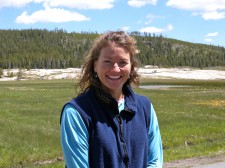
I have been to Yellowstone more than 200 times. As owner/publisher of Yellowstone Journal and YellowstonePark.com until last September (for the 15 years), I have found myself in Yellowstone often. I have enjoyed many days in the office that were out of this world, including days in the field with Yellowstone Wolf Project leader Doug Smith, (now retired) orinthologist Terry McEneaney, bear biologist Kerry Gunther, Yellowstone historian Lee Whittlesey, the late Rick Hutchinson, who was an amazing Yellowstone geology and geyser expert, and countless others. All of these were fascinating and educational experiences for me. While each was an interview for a story, each felt more like a privilege and an honor.
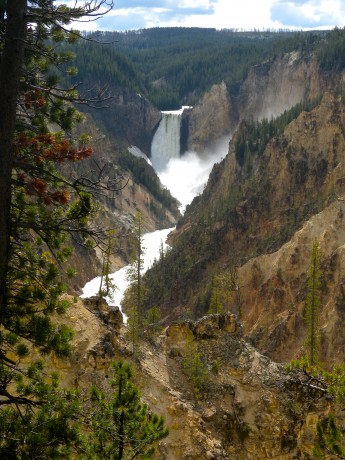
As a matter of fact, that’s how I feel every time I’m in Yellowstone. Lucky. Privileged. Blessed. I am still inspired with awe when I visit the world’s first national park. Even after 200+ visits to the Park, the sight of the Lower Falls, the Grand Canyon of the Yellowstone, Yellowstone Lake, Hayden Valley and Lamar Valley take my breath away.
Recently, my family embarked on a 1-day private tour with the Yellowstone Association Institute. The nonprofit Yellowstone Association educates Yellowstone National Park visitors by offering trip planners, books, videos, and guided classes through Yellowstone Park by our field institute. Learn more about their available courses and in-the-field opportunities.
Our goal with the tour? To see wolves and bears. That’s what everybody wants, right? And yet we were allowing only one day to achieve this, on June 18, which is was considered the tail end of peak season for spotting wolves and bears.
So, yeah, it was a tall order. And yeah, truth be told, if we didn’t see wolves and bears, we know Yellowstone well enough to know that any day in Yellowstone is better than a day anywhere else, and we’d have a heck of day, no matter if wolves or bears would present themselves or not.
We met our guide, Brad Bulin, at 6 am sharp at the Mammoth Hot Springs Hotel fireplace. We loaded into a minivan and off we went.
(NOTE: If you want to sleep in, fine, go for it. But the best wildlife viewing opportunities for visitors occurs in very early morning hours. If you’re willing to get up and start exploring Yellowstone at 6 a.m., you’ll be rewarded for it! You can sleep anytime…)
It was a rainy, cold, dreary morning. Perfect lighting and great weather for wildlife viewing, said Brad. As he said this, we stopped to view three large bull elk right next to the road. According to Bulin, bull elk’s antlers grow up to an inch a day during this time of year. The elk were so close we could see their fuzzy soft velvet on their growing racks.
As we viewed the elk, Bulin, a wildlife biologist in his sixth year of guiding interpretive tours for the Yellowstone Association Institute, provided some tips on how best to spot wildlife.
With these insights, we headed into the Northern Range and toward Lamar Valley, often (and aptly) called the “American Serengeti.â€

Well we weren’t 30 minutes into our tour and we were at a pullout looking through Brad’s scope at three bighorn rams in a high meadow and a large grizzly bear lumbering along below them at the base of the hill. We took turns watching the big bruin through Brad’s three scopes for a half hour. It was amazing! (After that, I thought to myself, Well that makes my day. If we don’t see anything but bison and elk from here on out, I’m happy.)

A little further down the road, we spotted a pronghorn, the fastest land animal in North America. Pronghorn, often mistakenly referred to as “antelope,†can run 65-70 miles per hour.
We viewed bison in several areas on both sides of the road, and right next to the road. The bison is one of my personal favorites given its history and resilience. Yellowstone’s bison are a remnant of a population that once numbered in the millions and inhabited much of what is now the U. S. In 1902, only a couple dozen of the animals remained, and they were in Yellowstone Park. An effort to restore and remain intact the population lead to the bison success story that still lives in Yellowstone. From that remaining tiny number of bison, today’s population grew. Today, there are 3,000-4,500 bison inhabiting Yellowstone National Park. The 2,000-pound animal is a sight to behold, particularly if you know its history and how far its come.
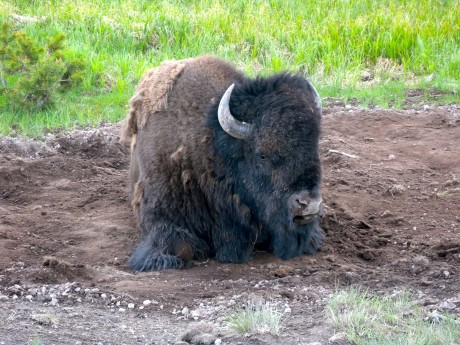
A little further yet, within the first 1.5 hours of our scenic tour through Yellowstone Park’s Northern Range, we spotted a black bear on our right, very close to the road. With the Lamar River running high behind it, the black bear laid on its tummy in the lush green grass, that was filled with small yellow wildflowers, and munched and munched. Compared to the enormous grizzly bear we had watched moments earlier, this black bear seemed young and small, and as our boys put it, adorable.
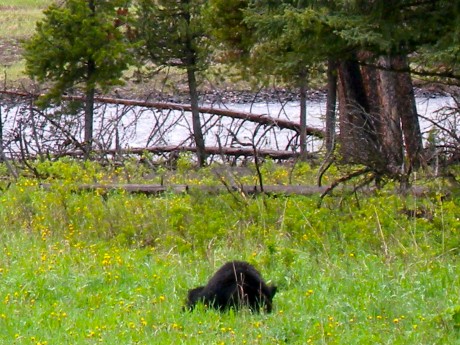
Wow, the day was shaping up to be a magnificent one! How could it realistically get any better, I said, and all of us agreed the day had already been a pretty darned special one.
It got more spectacular. Soon, there were two people looking through a scope at a pullout and looking at something high in the dark brown cliffs that were dotted with snow. They shared, enthusiastically, that they had spotted a mountain goat. Mountain goats are creamy white in color and inhabit very steep, high cliffs – terrain that most animals cannot dream of accessing. Seeing a mountain goat, despite the fact it’s not native to Yellowstone Park, would certainly be a treat. Brad set up his scopes and just like that, we were now looking at a mountain goat situated on a narrow cliff ledge high above us.
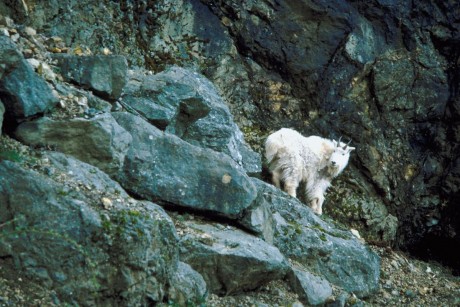 Man, what a morning! Could it get any better? None of us thought it possibly could.
Man, what a morning! Could it get any better? None of us thought it possibly could.
Still, Brad suggested we keep going “and search for a wolf.†(Wolves, honestly, were the animal we most wanted to see. Our oldest son, who is 9, is named Wolf. None of our three boys had ever seen a wolf in the wild and it was no secret they hoped to see one on today’s expedition.)
Well, if it’s wolves we wanted to see, it was wolves we’d get to see. We had pulled over to scan a hillside with our binoculars and scopes in hopes of catching a glimpse of some moving wild animal, when a passersby indicated to us that they had seen a wolf cross the road a little ways back down the road.
One thing that is ever present in Yellowstone’s Northern Range is this feeling of “community†and sharing that goes on amongst wildlife viewing enthusiasts. Wildlife watchers – “wolf watchers†in particular – are like a cult-like following of Yellowstone’s largest canid. Many of them visit year after year for weeks at a time with only one goal: to view wolves and observe their actions. They are generous with information on where they’ve seen what and when.
On the tip, we got back in the van and went a little ways to a pullout. Brad set up the scopes and sure enough, he spotted wolf 569, a gray wolf that is the alpha female of the Druid Peak Pack. Soon we had three scopes up as we watched the wolf run along the river in front of us.

To view wolves in the wild in Yellowstone is an amazing experience, and a unique and special event. Currently there are approximately 124 wolves, not including pups recently born, inhabiting Yellowstone National Park. After extermination in the 1920s and 1930s, the gray wolf was reintroduced to Yellowstone in the mid 1990s. Today the population in the park and flourishing and it’s believed that Yellowstone is now the #1 place in North America to view wolves in the wild from the roadside.
“Notice her bulging tummy,†said Brad. “She’s taking food back to her pups.†Right now the wolves are still at their den sites, where their new pups of the year have been holed up. During this stage of their lives, the alpha wolves, and other sub-adults have to often travel a great distance to hunt and get food. Then, they return to the den site where the adult wolves regurgitate the food to feed their young.
There we were, watching nature unfold right in our view. Wolf and Hayden each manned a scope and marveled at the sight of their first “real wolfâ€. They were practically frolicking they were so excited. Jerry and I were just as excited. As I was watching the the gray wolf trot along the river bank, I suddenly noted something black appear in the viewfinder right near the gray wolf. It was a black wolf. Two wolves! We watched for at least 30 minutes as the two wolves trotted, walked and made their way along the river bank. At one point the black wolf stopped and looked toward us and I could see the golden/yellow eyes. It was quite an experience, let me tell you.
After they got out of view, we loaded back into the van and continued to a pullout that was full of vehicles. After finding the last available parking spot, we unloaded and set up our scopes again. Some were watching an area they called the “corridor†… where wolf pups could occasionally be seen passing through pine trees. I caught a fleeting glimpse of two pups running through! Then, we turned our scopes back the way we had just come and again, for 30 minutes or so, watched the black wolf walk, run and take laying-down breaks.
It was amazing.
So, during the first few hours of our day, we had seen the following in the wild: bison, elk, pronghorn, grizzly bear, bighorn sheep, black bear, mountain goat, and wolves. We also saw a golden eagle, a hawk, a pronghorn with her newborn twins (which is a rare sight).
Toward the end, the rain let up just long enough for us to get out and explore some bones and diggings in a hillside.

Here’s a clip from the interpretation and insights our boys enjoyed receiving from Brad about a pile of bones they discovered during one of our stops:
To cap a stellar day, we took a short hike to see the Petrified Tree, a 50-million-year-old standing tree. The tree had been covered in volcanic ash during Yellowstone’s historic volcano eruptions and was later exposed, still standing. It’s quite a sight to see considering its age and current form.
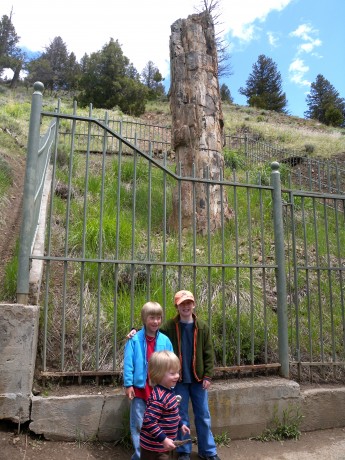
As usual, Yellowstone Park delivered. In far more ways than could have been expected.
The boys are still talking about all the things they learned. One thing this post doesn’t cover, because as it is, it’s lengthy, is all the tidbits of interesting information our instructor taught us. Things like how and what wolves hunt for food, how the coyote has adapted years of challenges, how fast a bison can run, how a coyote catches prey, how cow elk watch their young and remain in herds to prevent depredation from predators, how pronghorns keep their young hidden, scentless and concealed in an effort to avoid predation, and so much more.
I highly recommend the Yellowstone Association’s Institute courses or tours. There is no better way for visitors to get an up close and personal look at the various aspects of the world’s first national park.
Our experience was enriched as a result of our great day with Brad, and the interpretation, knowledge and expertise he provided that ultimately enabled us to see, and experience, so many awesome wildlife wonders. Xanterra Parks & Resorts, Yellowstone’s hotels and activities concessionaire, also offers Lodging & Learning Packages, which combine a variety of wonderful accommodations in the Park with Yellowstone Association Institute-led courses and tours.
Sure, it’s probably possible for a visitor to see all we did when we did without having a private tour, but it’s highly unlikely. And, you’ll miss out all the interpretation that definitely provided a lot of backstory to the animals and country we visited on our trip.
Start planningyour own vacation of a lifetime to Yellowstone Park, the world’s oldest national park, and my a favorite place in the world.